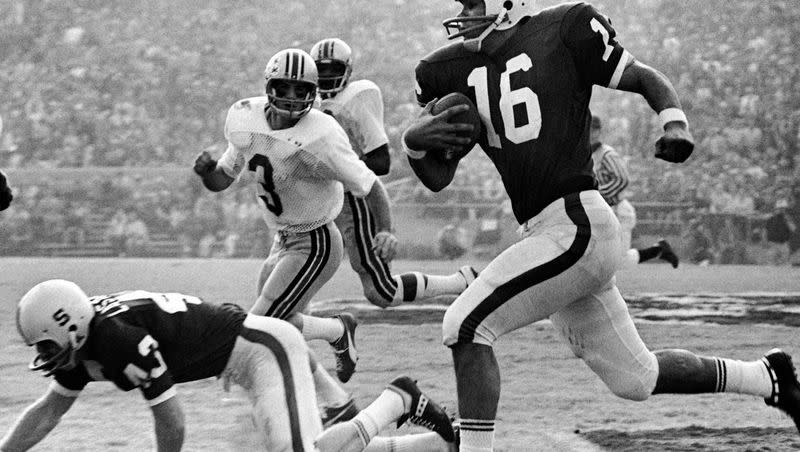Remembering the PAC-8, the Big 10 and the possible reunification of the old WAC teams

For about 10 bucks and a quick drive down El Camino Real to Stanford Stadium my parents and we four children enjoyed Saturday afternoons in the end zone to watch Stanford West Coast football. It was the 1970s. It was the PAC-8. And it all made sense since the eight universities in the Pacific Athletic Conference dotted the Pacific Coast.
These were days when every game was an afternoon game, back when football was a great family outing and win or lose, to a kid like me, it was always a great day in the sun.
Which makes all the Big Money TV nonsense driving college football so disappointing for those who remember the Stanford-Cal Big Game as really the Big Game of the year, just as BYU-Utah, USC-UCLA, and the other rivalries set the tone for each fan base.
When Big Game was at Berkeley, we drove the station wagon over the San Francisco Bay Bridge and competed with the throng for a parking spot. It was always a long walk to the stadium. But I enjoyed seeing the signs made on bed sheets hanging from the fraternity houses.
At the Big Game in 1970, Stanford was a championship team with soon-to-be Heisman trophy winner Jim Plunkett at quarterback and Randy Vataha at wide receiver. The frat boys had their say and it wasn’t profane: “Pluck Plunkett” read one hanging sheet. “Randy Vatahahahaha” read another. The Stanford Band, already notorious for perennial questionable behavior, liked to slingshot oranges or water balloons into the Cal band when it took the field to march each year. To a kid pulling for Stanford, it was hilarious.
Should college football be the same today? It’s a foolish question, as there is no going back. But fan consideration (think family friendly) should not be trumped by TV money. There has always been disruption. There will always be change, and sometimes it’s for the better.
Prince Lightfoot, who was portrayed by Timm Williams, a member of the Yurok Tribe, would take the field as the school mascot at Stanford games and perform native dance, back when Stanford teams were known as the Indians. Native American concerns came front and center to the Bay Area in 1969, however, when a group of Native Americans occupied Alcatraz Island, the site of the old prison in San Francisco Bay.
Some of those Native Americans involved were Cal Berkeley students who were there during the 19 month occupation. Soon, social movements which dominated the Bay Area, were on every campus and included football fields and sports arenas. Stanford abandoned the name “Indians” and its mascot, and become the Stanford Cardinal (the color, not the bird).
In that 1970 game, the Cal Bears beat Stanford 22-14, but Stanford still earned the right to play in the Rose Bowl facing Big 10 foe Ohio State, then ranked 2nd in the country. The Pac-8 champ beat the Big 10 champ 27-17. The New Year’s Day game was always a highlight for fans of both conferences, but change was coming.
Both BYU and Utah felt the brunt of conference realignment as chatter started in the mid 1970s for PAC-8 expansion. In 1976, the proposal was to include the two Arizona schools into the PAC-8, but Stanford, Washington and a few others weren’t in favor (Stanford said the Arizona schools lacked academic rigor, or something close to that).
But by 1978 Arizona and Arizona State were in, leaving their WAC original partners BYU, Utah, Wyoming and New Mexico to become something new. The PAC-8 became the Pac-10. The good news for BYU? It dominated the WAC and built a national brand under LaVell Edwards, culminating with a national championship in 1984.
That championship by BYU changed the landscape again, as the traditional football powers didn’t like a newcomer like BYU winning the championship. So folks in the SEC and elsewhere pushed for a change in the way champions are crowned and created the Bowl Championship Series for money and control. That ultimately provided a great opportunity for Utah which capitalized with championship seasons and wins over traditional powers like Alabama.
So what do we make of conference realignment in 2023?
Colorado is back to its BIG 12 roots. With USC and UCLA in their final year, it leaves 9 schools in the misnamed Pacific Athletic Conference. Arizona, Arizona State and Utah all have decisions to make about their athletic future. Clearly first choice was to make it work in the PAC-8, -10, -12, -10, -9, or whatever the final number becomes.
Ultimately, a reunion bringing four of the original WAC schools back together in a 16 team Big 12 conference would provide new opportunities and renew rivalries with programs that have grown in strength and prominence. Super conferences have been predicted for years, and whether it’s this year or in the decades to come, it is likely to happen.
The days of sitting in the end zone in the cheap seats are gone. Those banners hanging from fraternity row are more likely to display words not suitable for children. And it’s probably poor form to lob oranges at the school band. But school allegiances are strong not just for longtime fans, but also communities.
Money is king. But the health of the college game relies on so much more.
Doug Wilks is the executive editor of the Deseret News.

